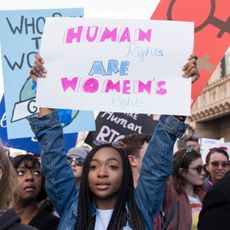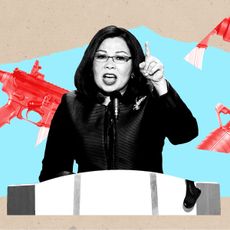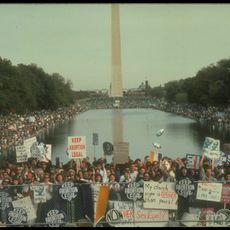

So much has changed since the 2008 election (and not just the grayness of Obama's hair). One of the biggest shifts in the political landscape has been on issues affecting women: many for the better, like gaining marriage equality for gay women—but some markedly for the worse. And when you take a close look at the political priorities of both sides of the aisle since then, it's no wonder that women's issues are now front and center for Democrats in the 2016 campaign.
Remember the "war on women"? It may seem like it's been raging since Biblical times, but the term refers to a very specific—and very recent—political phenomenon. It only came into widespread use after the 2010 elections, when the GOP took over the House and swept many state legislators, embarking on a series of abortion restriction laws and a legal campaigns against the Obamacare birth control provision. It was hugely successful; in the last four years alone, states have enacted 231 abortion restrictions.
And it's far from over. Recently, the Senate voted to defund Planned Parenthood for the first time, just a few days after the shooting at a Colorado clinic (the President has promised to veto the bill). A few years into this war on women, we're now seeing the consequences of restrictive state laws play out: a recent survey found that up to 240,000 Texas women have tried to give themselves an abortion by using black market drugs or other methods (the state of Texas now has only 17 active abortion clinics, down from 41 in 2012).
At the same time, incredible progress has been made in raising issues like paid family leave to the forefront of our national consciousness and political debate. And it's not by coincidence—after the 2012 election, the Democratic party realized that women were not only the majority of the electorate, but are more likely to go blue than men, so their strategy for the 2014 midterms focused heavily on women's issues (and not just reproductive rights).
The momentum has only grown as we near the 2016 presidential elections. Here's how women's issues fared last time vs. this time, and what the difference means:

Follow Marie Claire on Instagram for the latest celeb news, pretty pics, funny stuff, and an insider POV.
Stay In The Know
Marie Claire email subscribers get intel on fashion and beauty trends, hot-off-the-press celebrity news, and more. Sign up here.
Scarlet Neath is a freelance writer covering politics. Like Beyoncé, she is originally from Houston and now lives in New York.
-
 All the Easter Eggs and Name Drops on Taylor Swift's 'The Tortured Poets Department,' Explained
All the Easter Eggs and Name Drops on Taylor Swift's 'The Tortured Poets Department,' ExplainedDigging through the fan theories so you don't have to.
By Quinci LeGardye Published
-
 This Week's Best On-Sale Picks Include a Tory Burch Bag and Pretty Silver Ballet Flats
This Week's Best On-Sale Picks Include a Tory Burch Bag and Pretty Silver Ballet FlatsWarm weather is finally here—it's time to dress like it.
By Brooke Knappenberger Published
-
 A Sporty It-Sneaker Era Is About to Begin
A Sporty It-Sneaker Era Is About to BeginNike's next Air models are designed for Olympic athletes, but they'll soon be all over street style.
By Halie LeSavage Published
-
 36 Ways Women Still Aren't Equal to Men
36 Ways Women Still Aren't Equal to MenIt's just one of the many ways women still aren't equal to men.
By Brooke Knappenberger Last updated
-
 How New York's First Female Governor Plans to Fight for Women If Reelected
How New York's First Female Governor Plans to Fight for Women If ReelectedKathy Hochul twice came to power because men resigned amid sexual harassment scandals. Here, how she's leading differently.
By Emily Tisch Sussman Last updated
-
 Why the 2022 Midterm Elections Are So Critical
Why the 2022 Midterm Elections Are So CriticalAs we blaze through a highly charged midterm election season, Swing Left Executive Director Yasmin Radjy highlights rising stars who are fighting for women’s rights.
By Tanya Benedicto Klich Published
-
 Tammy Duckworth: 'I’m Mad as Hell' About the Lack of Federal Action on Gun Safety
Tammy Duckworth: 'I’m Mad as Hell' About the Lack of Federal Action on Gun SafetyThe Illinois Senator won't let the memory of the Highland Park shooting just fade away.
By Sen. Tammy Duckworth Published
-
 Roe Is Gone. We Have to Keep Fighting.
Roe Is Gone. We Have to Keep Fighting.Democracy always offers a path forward even when we feel thrust into the past.
By Beth Silvers and Sarah Stewart Holland, hosts of Pantsuit Politics Podcast Published
-
 The Supreme Court's Mississippi Abortion Rights Case: What to Know
The Supreme Court's Mississippi Abortion Rights Case: What to KnowThe case could threaten Roe v. Wade.
By Megan DiTrolio Published
-
 Sex Trafficking Victims Are Being Punished. A New Law Could Change That.
Sex Trafficking Victims Are Being Punished. A New Law Could Change That.Victims of sexual abuse are quietly criminalized. Sara's Law protects kids that fight back.
By Dr. Devin J. Buckley and Erin Regan Published
-
 My Family and I Live in Navajo Nation. We Don't Have Access to Clean Running Water
My Family and I Live in Navajo Nation. We Don't Have Access to Clean Running Water"They say that the United States is one of the wealthiest countries in the world. Why are citizens still living with no access to clean water?"
By Amanda L. As Told To Rachel Epstein Published